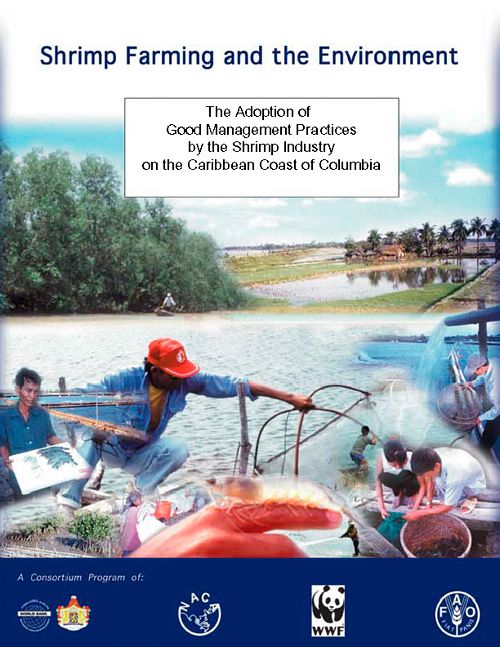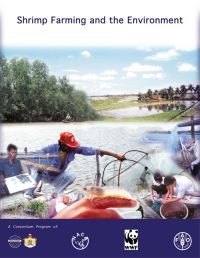The adoption of good management practices by the shrimp industry on the Caribbean coast of Colombia
31 May 2005 | Domonique Gautier | 1087 Downloads | .pdf | 1.81 MB | Better management practices, Livelihoods, gender and social issues, Shrimp, Environment and Sustainability
This report discusses the recent history of shrimp aquaculture along the Caribbean coast of Colombia, with a focus on effective management practices that have been implemented since the mid-1990s. While the primary reason for using different practices has been preventing outbreaks of shrimp diseases, many such practices provide environmental benefits as well. Examples include reducing the use of water (and other resources) as well as ensuring that effluent entering natural water bodies is at least as clean as the intake water.
Strong growth prevailed in Colombian shrimp production from the early 1980s to 1993, when Taura Syndrome hit the industry and spread throughout coastal shrimp farms. Many farms closed, some of these never reopened; other farms have bounced back, and total production has been growing again since 1997. Since the Taura outbreak, research efforts led by the nation’s industry association, Acuanal, have produced an ample domestic supply of broodstock and seedstock from animals selected for growth rates and resistance to disease. In addition to avoiding importation of shrimp and other marine animals that could carry disease, other elements of a biosecurity plan were implemented, including systematic disinfection of equipment, thorough testing, and certification that any animals to be moved from a facility are free of the viruses that cause White Spot Syndrome and Taura Syndrome, as well as the pathogens Baculovirus, Yellow-Head Virus (YHV), Infectious Hypodermal and Hematopoietic Necrosis Virus (IHHNV), and Necrotizing Hepatopancreatitis (NHP). Vibriosis occurs more commonly than any of the major diseases and is usually treated with antibiotics.
Biosecurity procedures are strict at hatcheries and nurseries, resulting in higher survival rates and healthier nauplii provided to the industry. The elements of ensuring biosecurity strive to prevent pathogen introduction or circulation, to diagnose quickly any disease that does appear and eliminate it, and to protect the genetic stock that is aquaculture’s foundation. So far, these preventive actions have protected the industry on the Caribbean coast, but farms on the Pacific coast were hit with WSSV in 1999, and most in that area were closed in 2000. Fortunately, all shrimp-related facilities in the Caribbean coastal area that were closed from disease outbreaks have reopened and resumed their activities.
After surveying many facilities (seven shrimp hatcheries and nurseries, six companies that own and manage nine farms, and two processing plants), the author reports on common practices in place in 2000. These practices are contrasted with those used in 1997, when an earlier survey was conducted, and numerous inputs and outputs are compared between the two years. The six aquaculture companies operate farms that account for 88% of the area in production on the Caribbean coast, and the two processing companies process about 90% of that coast’s total production. For each type of facility, the following topics are addressed: production methods, resource use, biosecurity measures, employment, efficiency, and economic aspects.
Shrimp farms in this area of Colombia have displaced undeveloped land or agricultural/ cattle farms that provided fewer jobs, rather than communities or communal resources. Destroying mangrove ecosystems has not been an issue for these farms; the small mangrove areas within farms have been preserved, as required by law. The farms as well as hatcheries, nurseries, and processing plants provide much-needed employment, and these jobs pay better and provide better benefits than the few other local options. Social services including schools, housing, and health care are often provided for local communities. Personnel turnover is very low. However, some workers, particularly those in processing plants, suffer from respiratory irritation and illnesses due to exposure to sodium metabisulfite, or skin irritation and infection from constant exposure to moisture.
The use of chlorine (increased since 1997) and sodium metabisulfite necessitates letting these residues dissipate in a tank or pond before discharging water, but not all farms have this equipment. Organic fertiliser use has diminished, but fertilisers (including inorganic ones) still pose risks of contaminating shrimp ponds and eutrophying natural water bodies. Hazardous waste collection and treatment methods have been improved at shrimp farms. Water use in shrimp farms has decreased since 1997, lowering energy costs and reducing total production costs. New legislation that levies a tax based on measured differences between intake and discharge water now provides facilities, especially processing plants, with the incentive to further reduce costs by eliminating contaminants from effluent.
In 2000, the average survival rate at the shrimp farms surveyed was 65 percent, a notable increase over 1997. Many factors contribute to the higher survival rates, including lower stocking densities and greater use of chlorine, as well as the improved health of post-larvae and screening for disease mentioned above. The costs of nauplii and PL have both been substantially reduced. Stocking densities have decreased since 1997 by 35% on average. In sum, the higher yields and survival rates that stem from the selective breeding program have increased production and profits as well as supported other changes that improve environmental impacts.
Challenges that remain for the Colombian shrimp industry include implementing comprehensive environmental management systems; finding less expensive (and domestic) sources of shrimp food, especially for brooders; further improving the biosecurity of facilities (investing in costly recirculation equipment); and discovering and addressing the factors that reduce pond productivity during the dry months, so the whole year can be used for production. Environmental management should be further improved, perhaps by adopting a generally accepted certification program. Acuanal, the industry association, is central to providing training and information to producers as well as representing their interests in negotiations with government agencies.
Copyright, all rights reserved.

